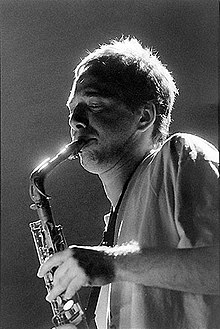The Big Gundown
| The Big Gundown | ||||
|---|---|---|---|---|
| Studio album by John Zorn | ||||
|
Publication |
||||
| Label (s) | Nonesuch / Icon, Tzadik | |||
|
Format (s) |
LP, CD |
|||
|
running time |
49:27 (74:54 - 15th Anniversary Edition) |
|||
| occupation |
|
|||
|
Studio (s) |
Radio City Music Hall Studios New York City |
|||
|
||||
The Big Gundown is an avant-garde album by John Zorn . It was recorded, compiled and released in 1986 by Don Hünerburg for Nonesuch Records from September 1984 to September 1985 . In 2000 the album was re-released in an expanded form on Zorn's Tzadik label. ( 15th Anniversary Edition ).
The music
The title of the album by the American composer, saxophonist and multi-instrumentalist John Zorn pays homage to the Italian film composer Ennio Morricone . It contains radically processed cover versions of the composer's film music for films by Claude Lelouch , Gillo Pontecorvo , Bernardo Bertolucci , Elio Petri and especially Sergio Leone . The title originally intended was Once Upon a Time in the Lower East Side , as a reference to Leone's classic Once Upon a Time in America . The title of the album ultimately chosen refers to a spaghetti western from 1966, The Big Gundown by Sergio Sollima with Lee Van Cleef in the lead role, for which Morricone wrote the music at the time. The film ran in Germany under the title The Hound of the Sierra Madre .
In addition to musicians from his regular environment from the New York jazz fusion and art rock avant-garde such as Bill Frisell , Arto Lindsay , Fred Frith and Wayne Horvitz, Zorn deliberately selected musicians who could be assigned to mainstream jazz or other genres, including harmonica player Toots Thielemans for the title Poverty from One Upon a Time in America , organist John Patton for his interpretation of Erotico from the film The Burglars, and singer Diamanda Galás and guitarist Vernon Reid for Metamorfosi , a theme from Elio Petri's film The Way of the Working Class to Paradise .
The Big Gundown laid the basis for Zorn's subsequent concept albums such as Spillane 1987 and Spy Vs Spy 1988.
The titles
- "The Big Gundown" - 7:26
- "Peur Sur La Ville" - 4:16
- "Poverty" (Once Upon A Time In America) - 3:49
- "Milano Odea" - 3:02
- "Erotico (The Burglars)" - 4:27
- "Battle Of Algiers" - 3:50
- "Giu La Testa" (Duck You Sucker!) - 6:06
- "Metamorfosi" (La Classe Operaia Va In Paradiso) - 4:37
- "Tre Nel 5000" - 4:37
- "Once Upon a Time in the West" - 8:44
- Other titles from the 2000 edition:
11. "The Sicilian Clan" - 3:20 am
12. "Macchie Solari" 3:29 am
13. "The Ballad Of Hank McCain" - 5:27 am
14. "Svegliati & Uccidi" 3:03 am
15. "Chi Mai" - 3:06
16. "The Ballad Of Hank McCain (instrumental) - 5:28"
- All compositions are by Ennio Morricone, with the exception of "Tre Nel 5000" by John Zorn
Effect and evaluation
Richard Cook and Brian Morton see John Zorn in the role of an artistic puppeteer and compare him to the role of George Martin in the recordings of the Beatles and the early Frank Zappa . They consider the album “remarkable in every way” and count it among the most important albums of the 1980s. They rated the work with the highest number of points, and added a crown.
Guy Peters considers the album to be genre-breaking and one of the riskiest of the 1980s. The album can be seen as one of the most successful advocates of the prevailing deconstructivist approach in literature and music: "John Zorn constantly walks the narrow line between admiration and imitation, which is also a consequence of the expressiveness of Morricone's work himself."
literature
- Richard Cook , Brian Morton : The Penguin Guide to Jazz on CD . 6th edition. Penguin, London 2002, ISBN 0-14-051521-6 .
Web links
Individual evidence
- ^ "John Zorn constantly walks the thin line between admiration and pastiche, which is also a consequence of the expressive nature of Morricone's music itself." Review by Guy Peters ( Memento of the original from July 19, 2012 in the Internet Archive ) Info: Der Archivlink was used automatically and not yet checked. Please check the original and archive link according to the instructions and then remove this notice.
